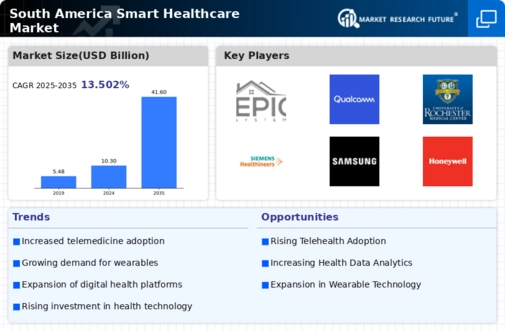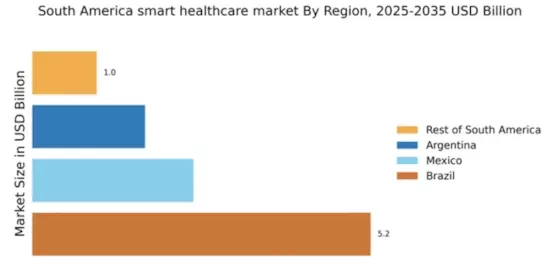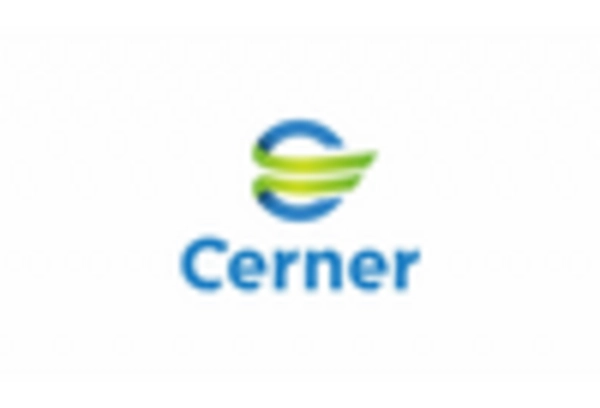Government Initiatives and Funding
Government initiatives and funding play a crucial role in propelling the smart healthcare market in South America. Various governments are recognizing the importance of digital health solutions and are allocating substantial budgets to enhance healthcare infrastructure. For instance, Brazil's Ministry of Health has launched programs aimed at integrating technology into healthcare services, with an investment of over $500 million in digital health initiatives. Such funding is likely to stimulate the development of smart healthcare technologies, including electronic health records and telehealth services. Furthermore, public-private partnerships are emerging, fostering innovation and collaboration in the smart healthcare market. These initiatives not only aim to improve healthcare access but also to enhance the quality of care provided to citizens, thereby driving market growth.
Increased Focus on Preventive Healthcare
The shift towards preventive healthcare is significantly influencing the smart healthcare market in South America. As healthcare systems evolve, there is a growing emphasis on preventing diseases rather than merely treating them. This paradigm shift is supported by the rising awareness among the population regarding health and wellness. The smart healthcare market is adapting by offering solutions that facilitate early detection and management of health conditions. For example, wearable devices that monitor vital signs and lifestyle factors are gaining traction, with a projected market growth of 20% in the next five years. This focus on prevention is likely to reduce healthcare costs in the long run, as it encourages healthier lifestyles and timely interventions, ultimately benefiting the overall healthcare system.
Technological Advancements in Healthcare
Technological advancements are a driving force behind the evolution of the smart healthcare market in South America. Innovations such as artificial intelligence, machine learning, and the Internet of Things (IoT) are transforming how healthcare services are delivered. These technologies enable healthcare providers to analyze vast amounts of data, leading to more accurate diagnoses and personalized treatment plans. For instance, AI-driven diagnostic tools are being integrated into clinical workflows, enhancing decision-making processes. The smart healthcare market is projected to grow by 18% annually, as these technologies become more accessible and affordable. Moreover, the integration of IoT devices allows for seamless communication between patients and healthcare providers, fostering a more connected healthcare ecosystem.
Rising Demand for Remote Patient Monitoring
The increasing demand for remote patient monitoring is a pivotal driver in the smart healthcare market. In South America, healthcare providers are increasingly adopting technologies that allow for continuous monitoring of patients' health metrics from their homes. This trend is fueled by a growing aging population, which is projected to reach 10% of the total population by 2030. Remote monitoring solutions not only enhance patient engagement but also reduce hospital readmission rates, which can be costly. The smart healthcare market in South America is expected to witness a growth rate of approximately 15% annually, driven by the need for efficient healthcare delivery and the rising prevalence of chronic diseases. As a result, healthcare systems are investing in innovative solutions that facilitate real-time data collection and analysis, ultimately improving patient outcomes.
Growing Investment in Health IT Infrastructure
The growing investment in health IT infrastructure is a key driver of the smart healthcare market in South America. As healthcare organizations recognize the importance of digital transformation, they are increasingly allocating resources to upgrade their IT systems. This investment is essential for implementing electronic health records, telemedicine platforms, and data analytics tools. In South America, it is estimated that health IT spending will reach $10 billion by 2026, reflecting a compound annual growth rate of 12%. Such investments not only enhance operational efficiency but also improve patient care quality. The smart healthcare market is likely to benefit from this trend, as robust IT infrastructure is crucial for the successful deployment of innovative healthcare solutions.


















Leave a Comment